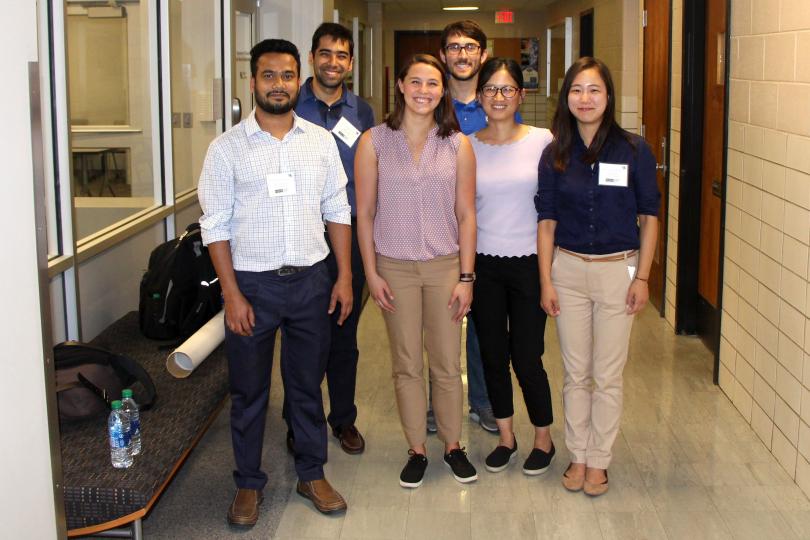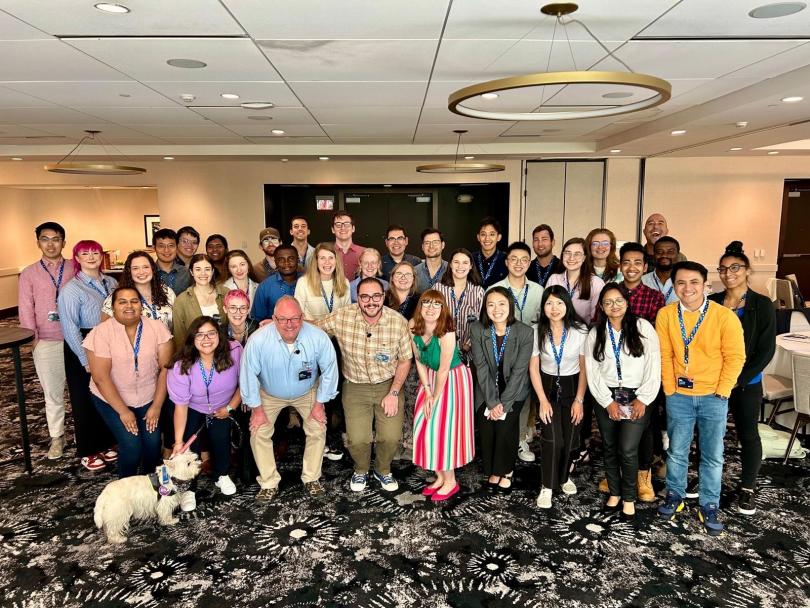By Jennifer T. Allen
LEXINGTON, Ky. – Rosemary Calabro found her love of research as an undergrad examining nanoparticles in materials chemistry. After graduating with her bachelor’s degree from Indiana University in Bloomington, she applied to many graduate schools searching for the perfect fit. That’s when she found professors Doo Young Kim and Dong-Sheng Yang at the University of Kentucky.
“Dr. Yang’s lab historically had been all laser spectroscopy, and I was the first materials person in his group,” said Calabro, who earned her doctorate in chemistry at UK in 2020. “Dr. Kim’s group was more carbon materials, which is what I was interested in studying, so I was able to bridge two interests and be co-advised.”
Calabro worked with carbon materials and also up-converting nanoparticles. One challenge with nanoparticles is synthesizing them. They are so small that if you change things like their size or their surface environment, you can change their properties dramatically, she explained.
“So you want to have control over that process, and that’s where the co-advising came in. I developed a strategy called laser ablation in liquid. We basically use a laser to make these nanoparticles,” Calabro said.
Calabro spent most of her time in the lab seeing how the laser ablation method could be adopted to make similar materials and understanding how laser parameters can change the structure of the particles. She even can incorporate different atoms to change the particles’ properties.

“I was working on controlling the structure function property and using a really unique method,” she said.
Since the nanoparticles Calabro worked with emit light, there are a lot of ways her research could be used, such as for photocatalysts, displays or biomedical applications, but she focused on controlling and understanding their emission properties.
“By controlling the colors of light that they emit, you can tune their behavior in certain applications. For example, when the nanoparticles are used in photocatalysis you need precise control over the colors and rate at which they emit,” Calabro said.
According to Calabro, the advantage of carbon materials is that they don’t use metals. A lot of electrocatalysis is done with metals such as platinum, which are very expensive. Carbon materials are metal-free, more abundant and lighter in weight.
Now at the U.S. Military Academy at West Point, Calabro credits her interest in government research with the Department of Chemistry offering seminars with people from various industries, including the Department of Energy Labs and Department of Defense.
“I remember a speaker from the Oak Ridge National Lab who made me think about government research as a career option,” Calabro said. “That was the first time I thought closely about government research, and it quickly became my primary goal.”
Calabro began as a postdoctoral researcher and recently transitioned to the research faculty at West Point in the Department of Chemistry and Life Science. She was also recently selected as one of the 2024 American Chemical Society’s CAS Future Leaders.

“I had applied before and not gotten it, so it was exciting to be selected this year. It is an awesome group of people, and we get leadership training and great networking opportunities,” she said. “I applied multiple times, and you learn from your application each time. I think it teaches you that just because you don’t get something once, doesn’t mean you shouldn’t apply in the future. It’s all a learning experience.”
Calabro is continuing her research on nanomaterials and is focusing on plasmonic nanoparticles and transition metal aerogels. Plasmonic nanoparticles change the color of light that they absorb, so if it encounters a certain gas or molecule you want it to sense, it’s going to change its optical properties, she said. The magnetic aerogels she works with have a lot of electrocatalysis applications. Calabro works in the Multifunctional Materials Lab and their focus is designing better materials for energy storage applications, such as batteries.
“The reason aerogels are a good option for replacing certain components is because they are so lightweight. If you think of a drone wing, you know a drone is very heavy and the lifetime of the battery that powers a drone is going to be influenced by the weight of it,” she said. “But if you could replace the wing with material that actually acts as a battery you could improve the battery life and decrease the weight of the material as well.”
During her time as a graduate student at UK, Calabro was able to gain more confidence in the classroom, which has served her well in her current position.
“West Point is considered primarily an undergraduate institution, and I get to work with a lot of cadets in the research group,” she said. “A lot of the teaching experience I gained at UK has helped me tremendously. I now get to do all of the fun parts of teaching, the research portion, without having to write or grade exams.”
Her early exposure to research as an undergraduate fueled her passion, and Calabro hopes to ignite that passion in others.
“My undergraduate research experience was very positive and I like being in the position to help guide undergraduates now,” she said. “They are learning how to do research, and I love being able to share my passion with others.”
